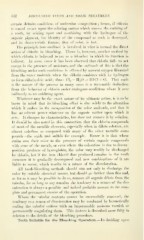Page 544 - My FlipBook
P. 544
542 DISCOLORED TEETH AND THEIR TREATMENT.
certain definite conditions of molecular composition ; hence, if cliloi'iii
is caused to act upon the coloring matter which causes the staininij^ of
a tooth, by seizing upon and combining with the liydrogen of the
organic pigment, the identity of the compound as such is destroyed,
and its characteristic feature, that of color, is lost.
The principle here outlined is involved in what is termed the direct
action of chlorin in bleaching. There is, however, another method by
which chlorin is believed to act as a bleacher in which its function is
indirect. In some cases it has been observed that chlorin fails to act
except in the presence of moisture, and the rationale of this is that the
bleaching under such conditions is effected by nascent oxygen liberated
from the water molecule when the chlorin combines with its hydrogen
to form chlorhydric acid ; thus : CI + H,() -= 2HC1 + O. That such
is the nature of the process in many cases is a reasonable deduction
from the behavior of chlorin under analogous conditions where it acts
indirectly as an oxidizing agent.
"Whatever may be the exact nature of its ultimate action, it is to be
borne in mind that its bleaching effect is due solely to the alteration
which it makes in the composition of the color molecule, and that it
has no solvent power whatever on the organic matter upon which it
acts. It changes its characteristics, but does not remove it by solution.
It should be also noted in this connection that the chlorin compounds
of most of the metallic elements, especially when in dilute solution, are
almost colorless as compared with many of the other metallic com-
pounds—the oxids and sulfids for example. Hence it is that where
stains owe their color to the presence of certain organic compounds
with some of the metals, or even where the coloration is due to decom-
position products of hemoglobin, the color may readily be discharged
by chlorin, but if the iron chlorid thus produced remains in the tooth
structure it is gradually decomposed and new combinations of it are
liable to occur, which results in a return of the discoloration.
All tooth-bleaching methods should aim not only to discharge the
color by suitable chemical means, but should go farther than this and,
as far as it may be possible to do so, remove all organic debris from the
tubules, for as long as any remains the tendency to a return of the dis-
coloration is always a ]iossible and indeed probable menace to the com-
plete and permanent success of the operation.
Where the tubular contents cannot be successfully removed, the
tendency to a return of discoloration may be combated by hermetically
sealing the tubular orifices with an impermeable resinous varnish or
permanently coagulating them. This feature is described more fully in
relation to the details of the bleaching procedure.
Teeth Suitable for the Bleaching Operation.—In deciding upon


